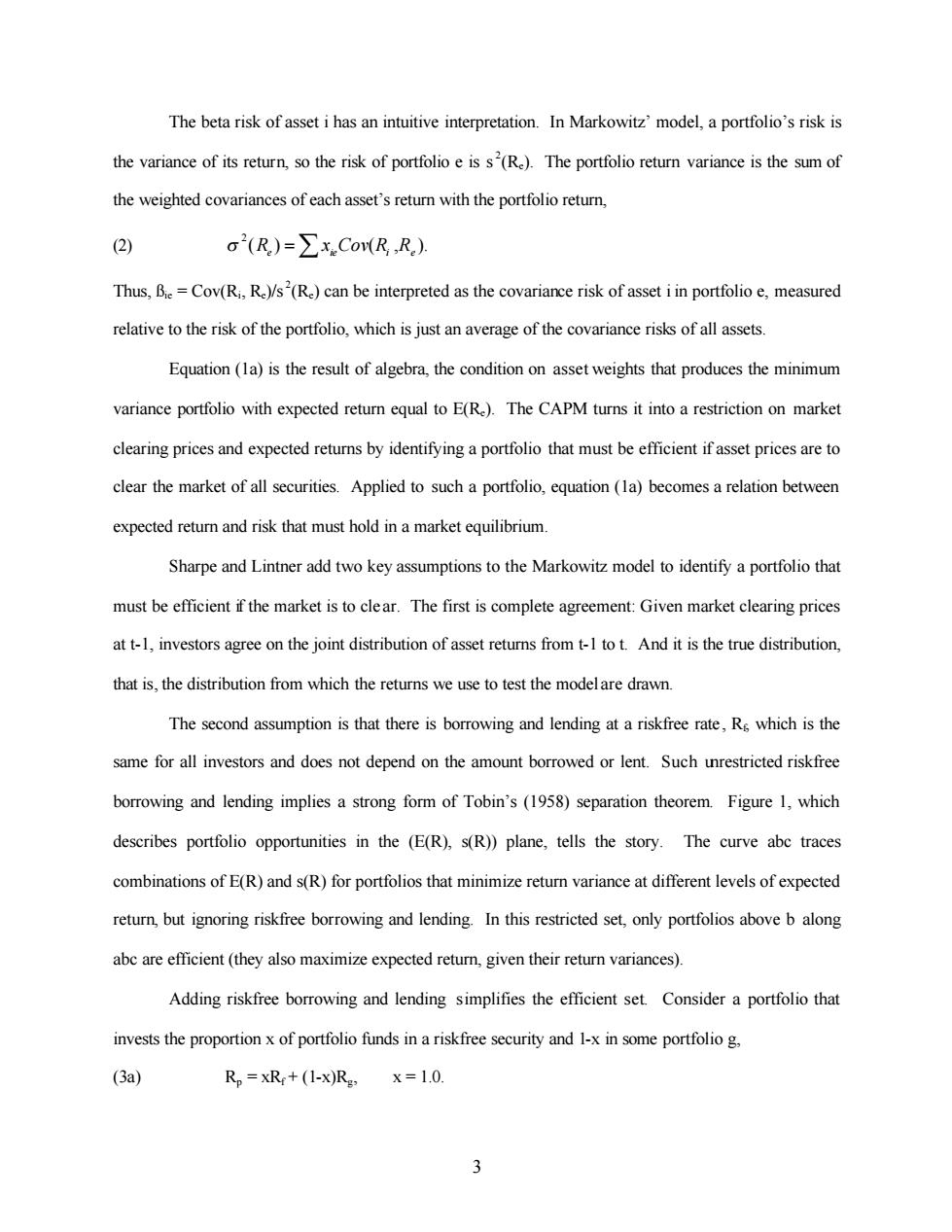正在加载图片...

The beta risk of asset i has an intuitive interpretation.In Markowitz'model,a portfolio's risk is the variance of its return,so the risk of portfolio e is s(Re).The portfolio return variance is the sum of the weighted covariances of each asset's return with the portfolio return, (2) o(R)=∑r.Cov(R,R) Thus,Bie=Cov(Ri,Re)/s'(Re)can be interpreted as the covariance risk of asset i in portfolio e,measured relative to the risk of the portfolio,which is just an average of the covariance risks of all assets. Equation (la)is the result of algebra,the condition on asset weights that produces the minimum variance portfolio with expected return equal to E(R).The CAPM turns it into a restriction on market clearing prices and expected returns by identifying a portfolio that must be efficient if asset prices are to clear the market of all securities.Applied to such a portfolio,equation (la)becomes a relation between expected return and risk that must hold in a market equilibrium. Sharpe and Lintner add two key assumptions to the Markowitz model to identify a portfolio that must be efficient if the market is to clear.The first is complete agreement:Given market clearing prices at t-1,investors agree on the joint distribution of asset returns from t-1 to t.And it is the true distribution, that is,the distribution from which the returns we use to test the model are drawn. The second assumption is that there is borrowing and lending at a riskfree rate,Rs which is the same for all investors and does not depend on the amount borrowed or lent.Such urestricted riskfree borrowing and lending implies a strong form of Tobin's (1958)separation theorem.Figure 1,which describes portfolio opportunities in the (E(R),s(R))plane,tells the story.The curve abc traces combinations of E(R)and s(R)for portfolios that minimize return variance at different levels of expected return,but ignoring riskfree borrowing and lending.In this restricted set,only portfolios above b along abc are efficient(they also maximize expected return,given their return variances). Adding riskfree borrowing and lending simplifies the efficient set.Consider a portfolio that invests the proportion x of portfolio funds in a riskfree security and 1-x in some portfolio g, (3a) Rp=xRe+(1-x)R2,x=1.0. J3 The beta risk of asset i has an intuitive interpretation. In Markowitz’ model, a portfolio’s risk is the variance of its return, so the risk of portfolio e is s 2 (Re). The portfolio return variance is the sum of the weighted covariances of each asset’s return with the portfolio return, (2) 2 ( ) ( , ). Re ie i e s =åx Cov R R Thus, ßie = Cov(Ri , Re)/s 2 (Re) can be interpreted as the covariance risk of asset i in portfolio e, measured relative to the risk of the portfolio, which is just an average of the covariance risks of all assets. Equation (1a) is the result of algebra, the condition on asset weights that produces the minimum variance portfolio with expected return equal to E(Re). The CAPM turns it into a restriction on market clearing prices and expected returns by identifying a portfolio that must be efficient if asset prices are to clear the market of all securities. Applied to such a portfolio, equation (1a) becomes a relation between expected return and risk that must hold in a market equilibrium. Sharpe and Lintner add two key assumptions to the Markowitz model to identify a portfolio that must be efficient if the market is to cle ar. The first is complete agreement: Given market clearing prices at t-1, investors agree on the joint distribution of asset returns from t-1 to t. And it is the true distribution, that is, the distribution from which the returns we use to test the model are drawn. The second assumption is that there is borrowing and lending at a riskfree rate , Rf , which is the same for all investors and does not depend on the amount borrowed or lent. Such unrestricted riskfree borrowing and lending implies a strong form of Tobin’s (1958) separation theorem. Figure 1, which describes portfolio opportunities in the (E(R), s(R)) plane, tells the story. The curve abc traces combinations of E(R) and s(R) for portfolios that minimize return variance at different levels of expected return, but ignoring riskfree borrowing and lending. In this restricted set, only portfolios above b along abc are efficient (they also maximize expected return, given their return variances). Adding riskfree borrowing and lending simplifies the efficient set. Consider a portfolio that invests the proportion x of portfolio funds in a riskfree security and 1-x in some portfolio g, (3a) Rp = xRf + (1-x)Rg, x = 1.0